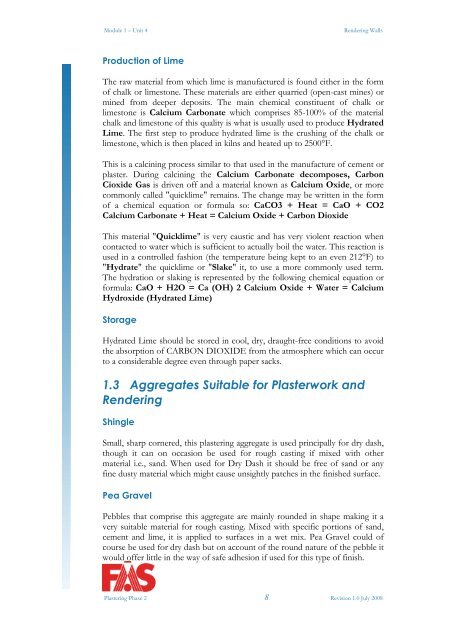TRADE OF PLASTERING - eCollege
TRADE OF PLASTERING - eCollege
TRADE OF PLASTERING - eCollege
You also want an ePaper? Increase the reach of your titles
YUMPU automatically turns print PDFs into web optimized ePapers that Google loves.
Module 1 – Unit 4 Rendering Walls<br />
Production of Lime<br />
The raw material from which lime is manufactured is found either in the form<br />
of chalk or limestone. These materials are either quarried (open-cast mines) or<br />
mined from deeper deposits. The main chemical constituent of chalk or<br />
limestone is Calcium Carbonate which comprises 85-100% of the material<br />
chalk and limestone of this quality is what is usually used to produce Hydrated<br />
Lime. The first step to produce hydrated lime is the crushing of the chalk or<br />
limestone, which is then placed in kilns and heated up to 2500°F.<br />
This is a calcining process similar to that used in the manufacture of cement or<br />
plaster. During calcining the Calcium Carbonate decomposes, Carbon<br />
Cioxide Gas is driven off and a material known as Calcium Oxide, or more<br />
commonly called "quicklime" remains. The change may be written in the form<br />
of a chemical equation or formula so: CaCO3 + Heat = CaO + CO2<br />
Calcium Carbonate + Heat = Calcium Oxide + Carbon Dioxide<br />
This material "Quicklime" is very caustic and has very violent reaction when<br />
contacted to water which is sufficient to actually boil the water. This reaction is<br />
used in a controlled fashion (the temperature being kept to an even 212°F) to<br />
"Hydrate" the quicklime or "Slake" it, to use a more commonly used term.<br />
The hydration or slaking is represented by the following chemical equation or<br />
formula: CaO + H2O = Ca (OH) 2 Calcium Oxide + Water = Calcium<br />
Hydroxide (Hydrated Lime)<br />
Storage<br />
Hydrated Lime should be stored in cool, dry, draught-free conditions to avoid<br />
the absorption of CARBON DIOXIDE from the atmosphere which can occur<br />
to a considerable degree even through paper sacks.<br />
1.3 Aggregates Suitable for Plasterwork and<br />
Rendering<br />
Shingle<br />
Small, sharp cornered, this plastering aggregate is used principally for dry dash,<br />
though it can on occasion be used for rough casting if mixed with other<br />
material i.e., sand. When used for Dry Dash it should be free of sand or any<br />
fine dusty material which might cause unsightly patches in the finished surface.<br />
Pea Gravel<br />
Pebbles that comprise this aggregate are mainly rounded in shape making it a<br />
very suitable material for rough casting. Mixed with specific portions of sand,<br />
cement and lime, it is applied to surfaces in a wet mix. Pea Gravel could of<br />
course be used for dry dash but on account of the round nature of the pebble it<br />
would offer little in the way of safe adhesion if used for this type of finish.<br />
Plastering Phase 2 8 Revision 1.0 July 2008

















